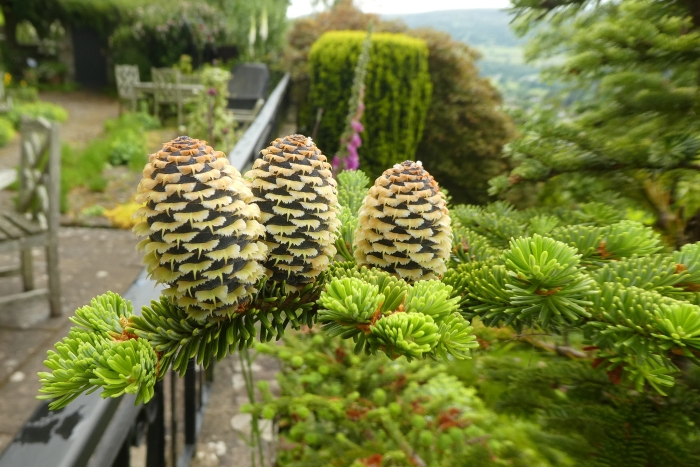Nordmann Fir
(Abies nordmanniana)
Nordmann Fir (Abies nordmanniana)
/
/

Mike Finn
CC BY 2.0
Image By:
Mike Finn
Recorded By:
Copyright:
CC BY 2.0
Copyright Notice:
Photo by: Mike Finn | License Type: CC BY 2.0 | License URL: https://creativecommons.org/licenses/by-sa/2.0/ | Uploader: muffinn | Publisher: Flickr |
























































Estimated Native Range
Summary
Abies nordmanniana, commonly known as Nordmann Fir, is an evergreen tree native to the mountainous regions of the Caucasus and northern parts of Turkey, where it thrives in moist, cool, mountainous forests, often forming pure stands or mixed with other conifers. It can grow to a majestic height of 55–61 meters with a trunk diameter of up to 2 meters, making it one of the largest European firs. The Nordmann Fir is characterized by its dense, symmetrical growth habit and a conical shape with glossy, dark green needles that are soft to the touch. The needles are arranged radially around the branches, contributing to the tree’s lush appearance. It produces cylindrical cones that are 10–20 cm long, which mature to a brown color.
The Nordmann Fir is highly regarded for its lush foliage and the fact that its needles are not sharp and do not drop readily, making it an ideal Christmas tree. Its resilience to drying and needle retention when cut are key reasons for its popularity during the festive season. In addition to its use as a Christmas tree, it is also a favored ornamental tree for parks and large gardens, providing year-round greenery and structure. The cultivar ’Golden Spreader’ has gained the Royal Horticultural Society’s Award of Garden Merit for its distinctive golden-yellow foliage. This fir prefers full sun to part shade and requires medium amounts of water, thriving in soils with medium drainage. While it is relatively low-maintenance, it can suffer from pests such as aphids and diseases like root rot if not properly cared for. It is also important to note that due to its potential size, it should be planted with ample space to accommodate its growth.CC BY-SA 4.0
The Nordmann Fir is highly regarded for its lush foliage and the fact that its needles are not sharp and do not drop readily, making it an ideal Christmas tree. Its resilience to drying and needle retention when cut are key reasons for its popularity during the festive season. In addition to its use as a Christmas tree, it is also a favored ornamental tree for parks and large gardens, providing year-round greenery and structure. The cultivar ’Golden Spreader’ has gained the Royal Horticultural Society’s Award of Garden Merit for its distinctive golden-yellow foliage. This fir prefers full sun to part shade and requires medium amounts of water, thriving in soils with medium drainage. While it is relatively low-maintenance, it can suffer from pests such as aphids and diseases like root rot if not properly cared for. It is also important to note that due to its potential size, it should be planted with ample space to accommodate its growth.CC BY-SA 4.0
Plant Description
- Plant Type: Tree
- Height: 35-50 feet
- Width: 15-25 feet
- Growth Rate: Moderate
- Flower Color: N/A
- Flowering Season: Non-Flowering
- Leaf Retention: Evergreen
Growth Requirements
- Sun: Full Sun, Part Shade
- Water: Medium
- Drainage: Medium
Common Uses
Bird Garden, Fragrant, Rabbit Resistant, Rock Garden, Salt Tolerant
Natural Habitat
Moist, cool, mountainous forests, often forming pure stands or mixed with other conifers
Other Names
Common Names: Caucasian Fir, Nordmann Christmastree, Jedle Kavkazká, Nordmann-Tanne, Kaukasische Tanne, Nordmanns-Tanne, Nordmannstanne, Abeto De Nordmann, Abeto Del Cáucaso, Sapin De Nordmann
Scientific Names: , Abies nordmanniana, Abies cephalonica var. greaca, Abies leioclada, Abies nordmanniana f. aurea, Abies nordmanniana f. pendula, Abies nordmanniana f. robusta,
GBIF Accepted Name: Abies nordmanniana (Steven) Spach